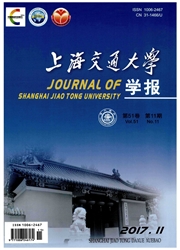

 中文摘要:
中文摘要:
介绍了平板远场涡流检测系统的基本结构和基本检测原理.根据检测时系统中磁力线和能量的分布特点,提出了能量凹陷区的概念.利用电磁数值仿真技术,给出了远场涡流检测中导体板无缺陷和有缺陷时,感应线圈处对检测信号起主要作用的方向的磁通密度分布变化特点.对比分析了板中不同深度和不同半径平底孔缺陷对感应线圈处磁通密度分布的不同影响.分析结果表明,因缺陷引起的空间磁通密度分布曲面形状与缺陷形状间有较直观的对应关系.最后,给出了实际平板远场涡流检测实验中,铁板上下表面存在不同尺寸平底孔缺陷时的远场检测信号曲线,显示出缺陷的半径、深度及位置对检测信号的不同影响.
 英文摘要:
英文摘要:
The fundamental structure and the basic detection principle of the plate remote-field eddy current testing system were introduced. According to the distribution characteristics of the magnetic flux and the energy of the testing system, a novel concept related to the hollow area in the energy was proposed. Simu- lation techniques were used to obtain the distribution characteristics of the magnetic flux density in the di- rection which mainly influenced the output signal, in the plane where the detection coil was placed, and in the presence or otherwise of a fault in the conductor plate. In particular, the influence of flat-bottom hole flaws of varying depths and radii on the magnetic flux density was analyzed. The analysis showed that the change in the magnetic flux density distribution was directly related to the shape of the fault. The test re- sults for low-frequency remote field signals for the plate were given with hole flaws appearing on the top or bottom of the plate. The test curves showed the different influences of the depth, radius, and location of the flaw on the detection signal for the tested material.
 同期刊论文项目
同期刊论文项目
 同项目期刊论文
同项目期刊论文
 Study of lift-of invariance transformation method for quantitative defect estimation in eddy current
Study of lift-of invariance transformation method for quantitative defect estimation in eddy current Study on defect classification in multi-layer structures based on Fisher linear discriminate analysi
Study on defect classification in multi-layer structures based on Fisher linear discriminate analysi Defect detection and identification in eddy current testing using subtractive clustering algorithm c
Defect detection and identification in eddy current testing using subtractive clustering algorithm c 期刊信息
期刊信息
